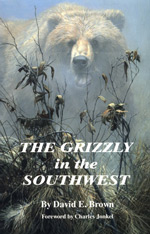Review of "The Grizzly in the Southwest"

Author(s): David E. Brown
Published: September 1996, University of Oklahoma Press, ISBN: 0806128801
 by James A. Huggins, Ph.D., University Professor & Director of the Hammons Center for Scientific Studies
by James A. Huggins, Ph.D., University Professor & Director of the Hammons Center for Scientific Studies
June 174, 2004 -
At the beginning of the 19th century population estimates for the Grizzly (Ursus arctos) across the United States was estimated at over 100,000 animals. At this juncture in time, this magnificent animal occupied on this continent a huge and contiguous range over the northern and western portions of our country, across most of Canada and into Alaska. Today US grizzlies exist as six relatively isolated populations in four of the 48 contiguous states and their numbers have dwindled to less than 1000 individuals. Populations have therefore been drastically reduced and fragmented to a point that many conservation minded Americans are concerned for its well being. I am one of those Americans. The Grizzly in the Southwest is, as advertised, a documentary of extinction; it deals particularly with the subspecies of grizzly (Ursus arctos nelsoni) that once occupied our American southwest and Mexico. While it is not a unique book in that it documents extinction (see California Grizzly (Ursus arctos californicus) by Storer and Tevis or The Passenger Pigeon; Its Natural History and Extinction by Schoger), it is a very instructive one. It has now gone through a second addition and has therefore been around for a while. However, in an age when humanity is on the verge of losing much of what God has given us in the way of biodiversity, I found it helpful to review an historical account that documented the human eradication of another of God’s creatures.
Environmental history is, in fact there is at least one university that now has an endowed “chair” of environmental history, increasingly being recognized as important. To a conservation minded society that must make some decisions soon, it is indispensable. Hopefully works like these will help us learn from the past and guide us to effective strategies that will serve the conservation and preservation needs of a world community. Dr. Brown has therefore been ahead of time in that he saw the need to document the conflicts that arose between one aspect of nature, bears, and humans. He briefly explores the many facts that led to the demise of the Southwest grizzly: the economic conditions that drove the Homestead Act of 1862 and the subsequent settlement of the West , cattle prices of the 1880’ & 1890’s that led to the bust up of the larger and slightly more friendly cattle ranches (giving way to larger numbers of people and smaller homesteads), and the advent of the railroad that would bring in people and take cattle to the market, and the inevitable war between the bruin and the livestock industry. Brown does a good job of using historical data to document the natural history of this subspecies and of illustrating that the very complex and circular relationship between omnivores like bears and the herbivores of men.
Because these animals are what biologist describe as K-selected species, i.e. animals with low reproductive rates, having long maturation periods for few offspring that must be cared for over a relatively long period of time, needing large areas for specific habitat, many have felt that these animals may still be “set up” for still more problems as a species. Indeed, recent studies, augmented with computer analyses designed to explore the effective population size for these bears, have suggested that our grizzly may still face future crises. The six relatively small breeding populations in the contiguous US face a potential problem with inbreeding and loss of genetic variability resulting in a loss of fitness. Consequently special management techniques, such as transporting males from one population to another to simulate natural immigration, may be necessary to main viable populations. Biology can and should contribute much to the survival of those creatures that share a home with a species that seems to have no limit to its own planetary demands.
In 1974 Dr. Brown wrote a resolution proposing the reintroduction of grizzlies to the Southwest. Though the recent reintroduction of the wolf over portions of its previous range may bode well for such an attempt, it is doubtful that his resolution will ever gain enough support to reintroduce such a powerful predator. Time will tell. In the meantime, the only southwest grizzlies to be observed today are taxidermy specimens that may be viewed as a family group on display at the Filed Museum of Chicago. They were harvested in 1901 from the Sierra Madre of Chihuahua, Mexico.

